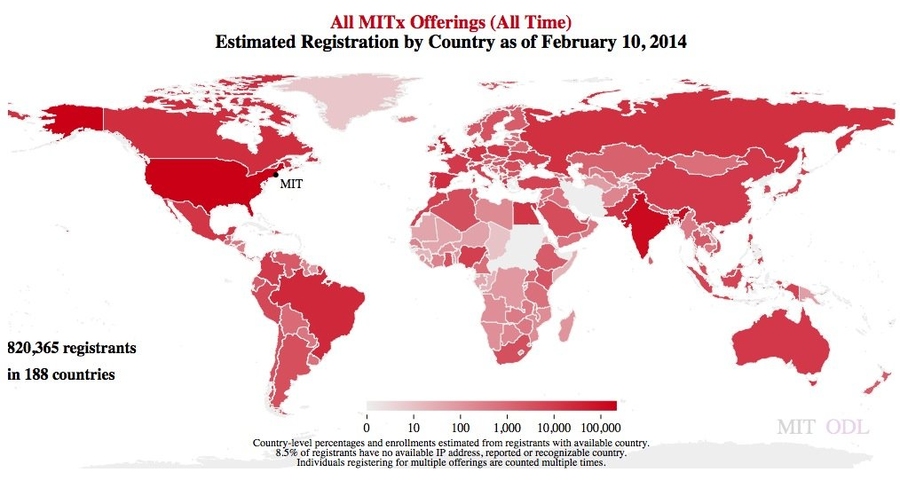Following the recent release of a series of working papers based on 17 online courses from Harvard and MIT offered on the edX platform, researchers have made available an initial dataset of registration and demographic information coupled with a suite of open-source interactive visualization tools for MITx and HarvardX courses.
The tools, dubbed Insights, draw upon near-real-time, de-identified data of course registrants, dynamically updating at frequent intervals. Initially harnessing information on 1,055,562 total registrants, the tools provide an intuitive way to review individual courses across a number of metrics, including global enrollment, certificate attainment, gender and age composition, and education levels, all viewable country-by-country on a world map. The tools also feature HarvardX-wide and MITx-wide statistics.
Developed collaboratively by Sergiy Nesterko, a research fellow at HarvardX, and Daniel Seaton, a postdoctoral research fellow at MIT’s Office of Digital Learning, the information and tools are an initial step in sharing data generated from massively open online courses (MOOCs) to advance learning science.
“These tools provide our faculty and course developers, as well as the general public, usable, visually interpretable data from course offerings in near real time,” Nesterko says. “This can help to guide instruction while courses are running and deepen our understanding of the impact of courses after they are complete.”
For example, Insights shares HarvardX and MITx course registrations from China, highlighting how technical barriers such as the blocking of YouTube and firewalls influence participation. The tools can also shed light on common claims, such as the claim that MOOCs primarily serve male, highly educated students. It turns out that gender and education demographics vary dramatically across different countries and courses.
“Our hope is that these tools will be useful to everyone, including researchers, journalists, course developers, and the public, for the purpose of understanding how these courses work and who our students are,” Seaton says.
The interactive tools, originally conceived by Nesterko, were used for open online courses offered by HarvardX. Seaton later adapted the suite for use by MITx, demonstrating how Insights can be customized to particular institutions.
Because the code is open-source, and the aggregated datasets are downloadable, interested users can modify and build upon existing functionality. In the future, Nesterko and Seaton plan to expand the Insights toolkit to include distinctions between “auditors” and “enrollees.”
The researchers anticipate that ultimately other edX consortium members, and potentially schools using other open learning platforms, will use the tools to enable rich multi-institutional studies.
The tools, dubbed Insights, draw upon near-real-time, de-identified data of course registrants, dynamically updating at frequent intervals. Initially harnessing information on 1,055,562 total registrants, the tools provide an intuitive way to review individual courses across a number of metrics, including global enrollment, certificate attainment, gender and age composition, and education levels, all viewable country-by-country on a world map. The tools also feature HarvardX-wide and MITx-wide statistics.
Developed collaboratively by Sergiy Nesterko, a research fellow at HarvardX, and Daniel Seaton, a postdoctoral research fellow at MIT’s Office of Digital Learning, the information and tools are an initial step in sharing data generated from massively open online courses (MOOCs) to advance learning science.
“These tools provide our faculty and course developers, as well as the general public, usable, visually interpretable data from course offerings in near real time,” Nesterko says. “This can help to guide instruction while courses are running and deepen our understanding of the impact of courses after they are complete.”
For example, Insights shares HarvardX and MITx course registrations from China, highlighting how technical barriers such as the blocking of YouTube and firewalls influence participation. The tools can also shed light on common claims, such as the claim that MOOCs primarily serve male, highly educated students. It turns out that gender and education demographics vary dramatically across different countries and courses.
“Our hope is that these tools will be useful to everyone, including researchers, journalists, course developers, and the public, for the purpose of understanding how these courses work and who our students are,” Seaton says.
The interactive tools, originally conceived by Nesterko, were used for open online courses offered by HarvardX. Seaton later adapted the suite for use by MITx, demonstrating how Insights can be customized to particular institutions.
Because the code is open-source, and the aggregated datasets are downloadable, interested users can modify and build upon existing functionality. In the future, Nesterko and Seaton plan to expand the Insights toolkit to include distinctions between “auditors” and “enrollees.”
The researchers anticipate that ultimately other edX consortium members, and potentially schools using other open learning platforms, will use the tools to enable rich multi-institutional studies.






